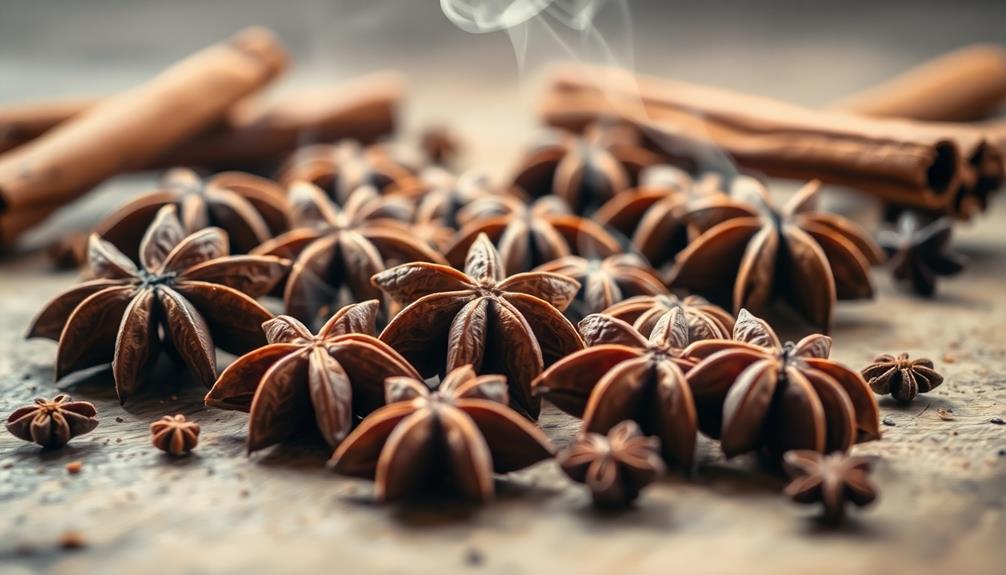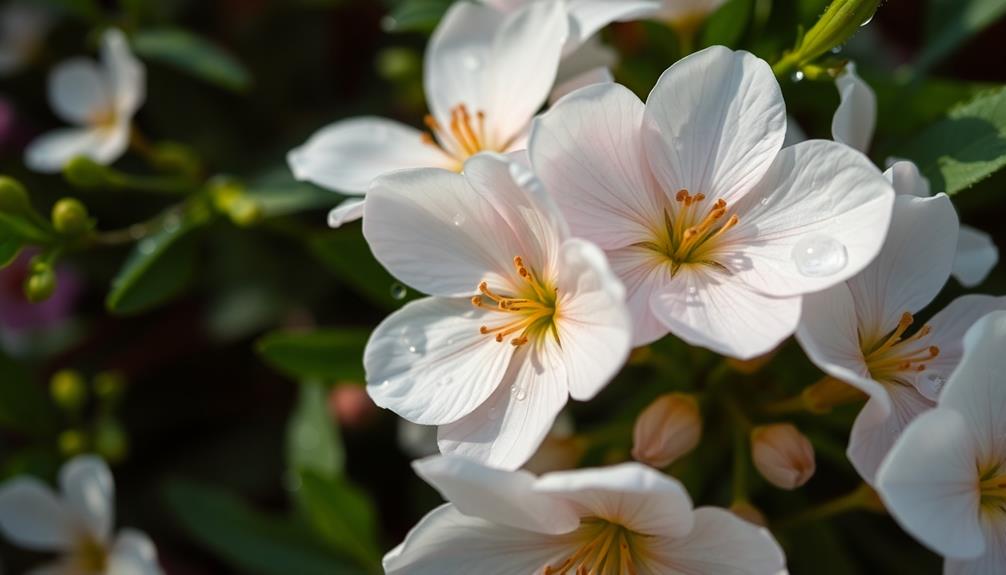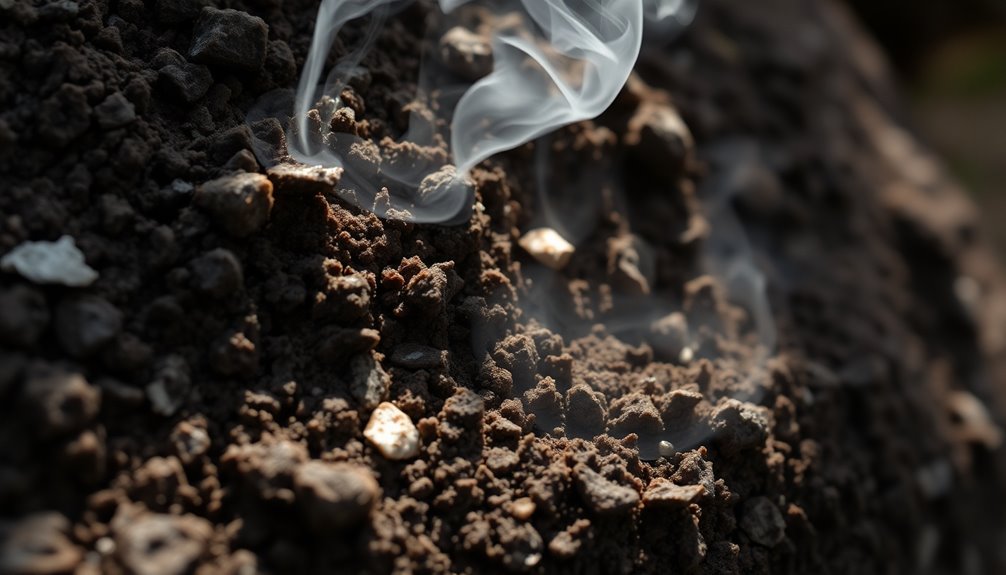Star anise has a unique smell that you'll find bold and sweet. It combines spicy sweetness with a strong licorice scent, thanks to anethole, which gives it that distinct aroma. As you experience its fragrance, you might notice the sharpness of the licorice fades into warming, balsamic undertones that feel cozy and inviting. You'll often encounter this lovely scent in cooking and during cozy seasons. Whether it's in a fragrant candle or a delicious dish like Pho, the aroma of star anise can create a wonderful atmosphere. Keep exploring to discover more about its uses and benefits!
Key Takeaways
- Star anise has a bold, spicy sweetness characterized by a prominent licorice-like scent due to its primary compound, anethole.
- The fragrance begins with a sharp licorice note that transitions into warm, balsamic undertones, creating a comforting aroma.
- Its essential oil retains a potent, spicy aroma, making it suitable for culinary and aromatic applications.
- Commonly found in cozy environments, star anise evokes warmth and nostalgia, enhancing the atmosphere during gatherings and meals.
- The scent pairs well with other warm spices like cardamom and cinnamon, adding complexity and depth to dishes and fragrances.
Introduction

When you take a whiff of star anise, you're immediately drawn in by its bold and captivating scent. This unique fragrance has a spicy sweetness that's hard to forget. You might notice that it carries a licorice-like scent, which can remind you of other aromatic herbs like fennel. This scent profile is mainly due to anethole, a compound that gives star anise its distinctive aroma.
Star anise essential oil is a nearly colorless liquid that keeps this powerful scent intact. It's not just for cooking; it's popular in perfumery and aromatherapy too!
If you're using star anise essential oil, you'll find that its intense aroma pairs nicely with warm spices such as cardamom and cinnamon. It also blends well with fresh scents like mandarin and peppermint, adding a delightful complexity to the overall experience.
As you explore the world of star anise, you'll discover that its warming, balsamic undertones can provide a comforting depth. Each sniff reveals more layers, inviting you to appreciate this fascinating spice and its versatile uses.
Description of the Smell
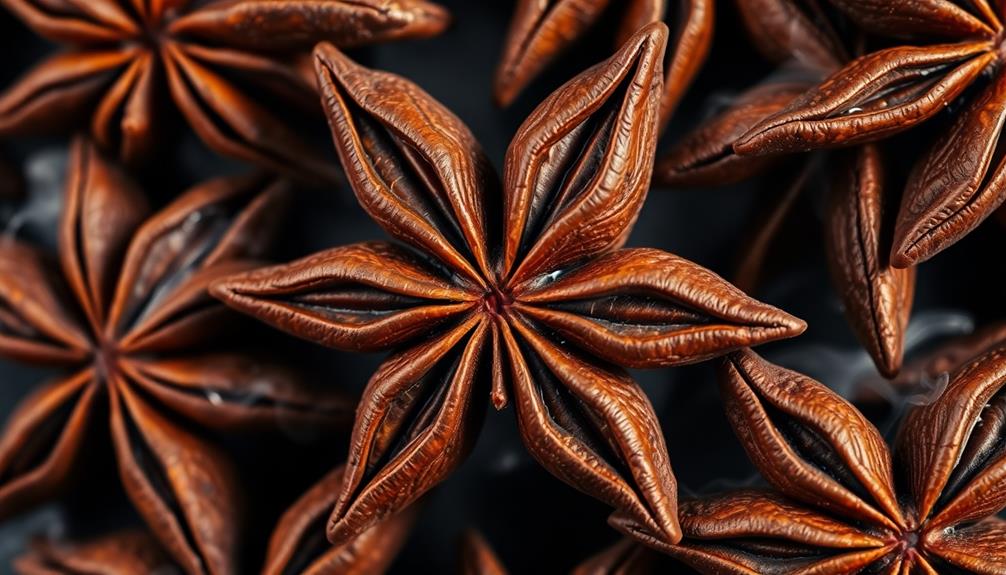
Star anise boasts an unmistakable fragrance that captivates and intrigues. When you take a whiff of its aroma, you'll notice a bold scent filled with spicy sweetness and a sharp, licorice flavor that stands out. This unique combination makes star anise smell intense and inviting, perfect for adding warmth to various dishes and fragrances. Star anise pairs exceptionally well with spices such as cinnamon, cloves, and fennel, enhancing both savory and sweet culinary creations. Its rich aroma is not only popular in cooking but also finds its way into perfumes, where it complements an iris scent profile with its complex and exotic notes. In this way, star anise adds a distinctive warmth to fragrances, balancing the floral undertones of iris with its spicy and licorice-infused depth.
As the scent unfolds, it reveals warming, balsamic undertones that create a comforting depth. You might find that the initial burst of licorice sharpness gradually evolves, making the experience even more delightful.
The essential oil extracted from star anise is nearly colorless but retains that potent, spicy aroma, making it a popular choice in perfumery and aromatherapy.
Source and Composition
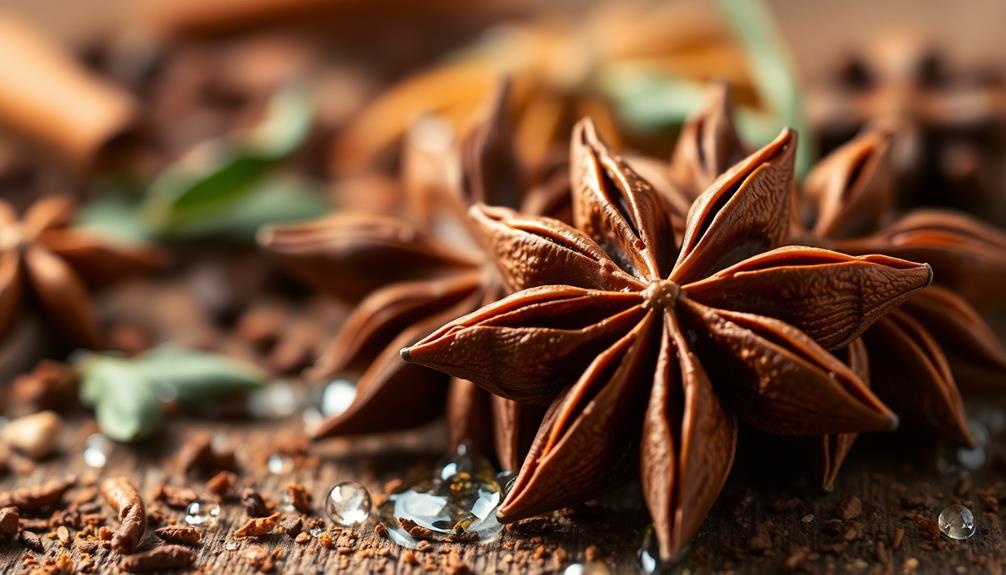
The captivating aroma of star anise comes from its unique source, scientifically known as Illicium verum. This lovely spice isn't just about its looks; it's the aromatic compounds that make it special. The primary compound, anethole, gives star anise its strong, sweet scent, often likened to licorice. When you smell it, you might also catch hints of woody and balsamic undertones, adding to its warm and bold fragrance.
To get that delightful scent, people extract anise oil from the star-shaped fruits through a process called steam distillation. This method helps separate the essential oil, which is nearly colorless and packed with a potent aroma. The oil usually contains about 2.5% to 5% essential oil content, coming from the aromatic seeds inside the fruit.
In addition to anethole, the scent of star anise has spicy-sweet notes that make it even more interesting. That's why you'll find star anise not just in your kitchen but also in perfumery, where its rich fragrance can brighten up many products.
Typical Scenarios or Environments

In various cozy settings, you'll often encounter the enchanting aroma of star anise, especially during the cooler months. This bold and captivating scent fills your space with a spicy sweetness reminiscent of licorice, creating an inviting atmosphere.
When you light a star anise-scented candle, the warming, balsamic undertones add a comforting depth, perfect for snuggling up at home.
You might find star anise featured prominently in culinary settings, especially in delicious dishes like Vietnamese Pho. Its rich and aromatic fragrance can transform a simple meal into a delightful experience, making your kitchen feel warm and welcoming.
In aromatherapy, star anise shines as a popular choice due to its powerful scent. It's often blended with other warm spices like cardamom and cinnamon, enhancing the overall fragrance experience.
This combination evokes seasonal warmth and can make any gathering feel special.
Whether you're cooking, relaxing, or enjoying a festive gathering, the aroma of star anise adds a magical touch to your surroundings.
Emotional or Cultural Associations
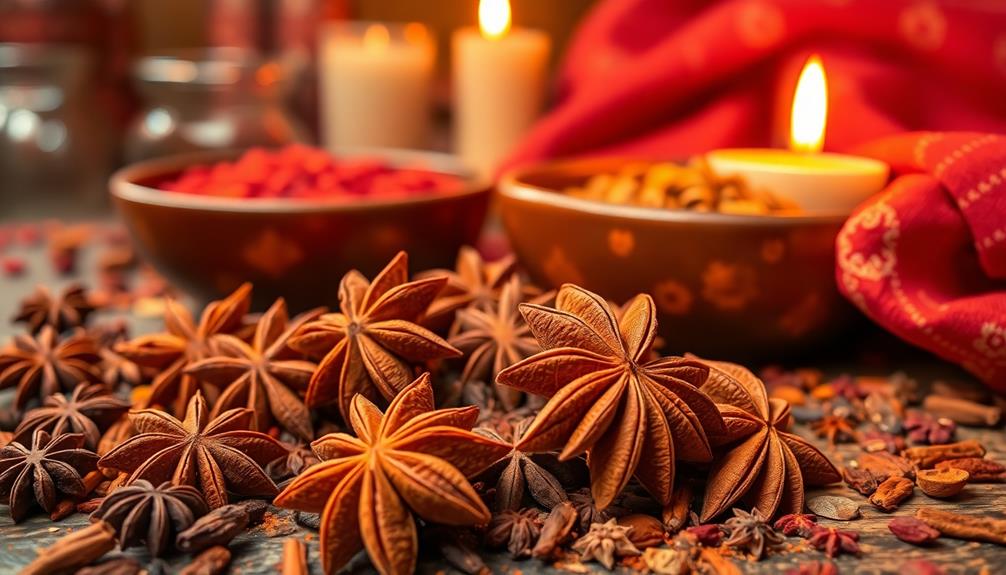
With its bold, spicy sweetness, star anise evokes a sense of warmth and comfort that many people cherish. When you breathe in its rich aroma, you might feel a wave of nostalgia, reminding you of family gatherings and festive meals. This unique scent often appears in holiday recipes, bringing people together and creating lasting memories.
In various cultures, star anise is more than just a spice; it's tied to traditions and rituals. In traditional Chinese medicine, it's believed to have protective qualities, helping to ward off negative energies. This connection to well-being enhances the emotional ties people have with anise.
You might find star anise in dishes like Vietnamese Pho or Chinese five-spice blends, connecting you to global cuisines and their rich histories. Its scent is even used in aromatherapy to promote relaxation and emotional balance, showcasing its role in herbal medicine.
Health or Safety Considerations
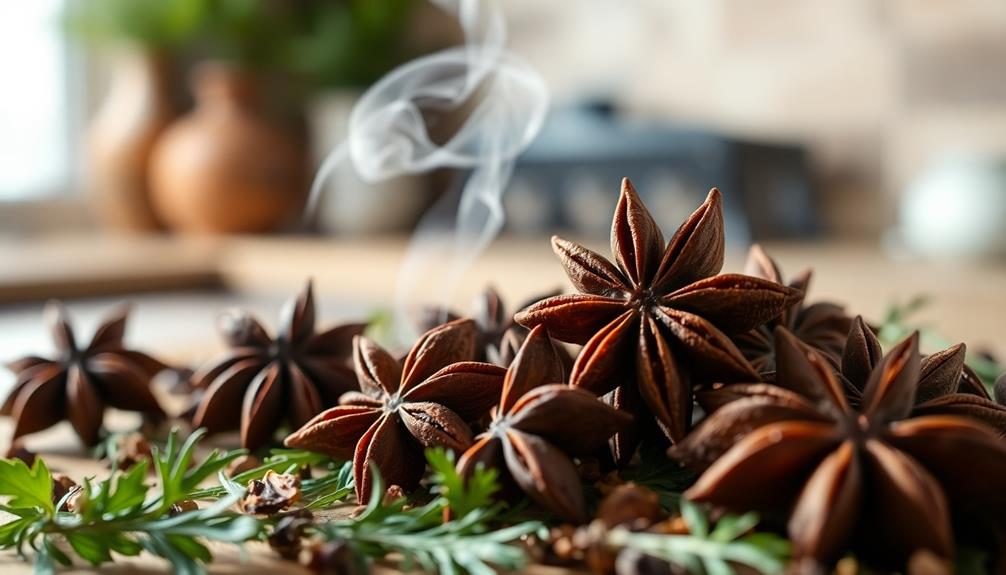
Enjoying the warm and comforting aroma of star anise comes with some health and safety considerations. While star anise is generally safe, it contains a compound called anethole, which can cause allergic reactions in some people. If you know you're sensitive to anise, it's best to steer clear.
Be cautious with the essential oil of star anise, too. Applying it undiluted can irritate your skin or trigger allergic reactions. If you're thinking about using star anise supplements or oils, especially if you're pregnant or breastfeeding, consult your healthcare provider first. There's limited safety data on its effects during these times.
Also, keep in mind that excessive consumption of star anise can lead to toxicity, especially in infants.
If you're on medication, talk to your doctor before using star anise, as it can interact with certain medications processed by the liver.
Final Thoughts
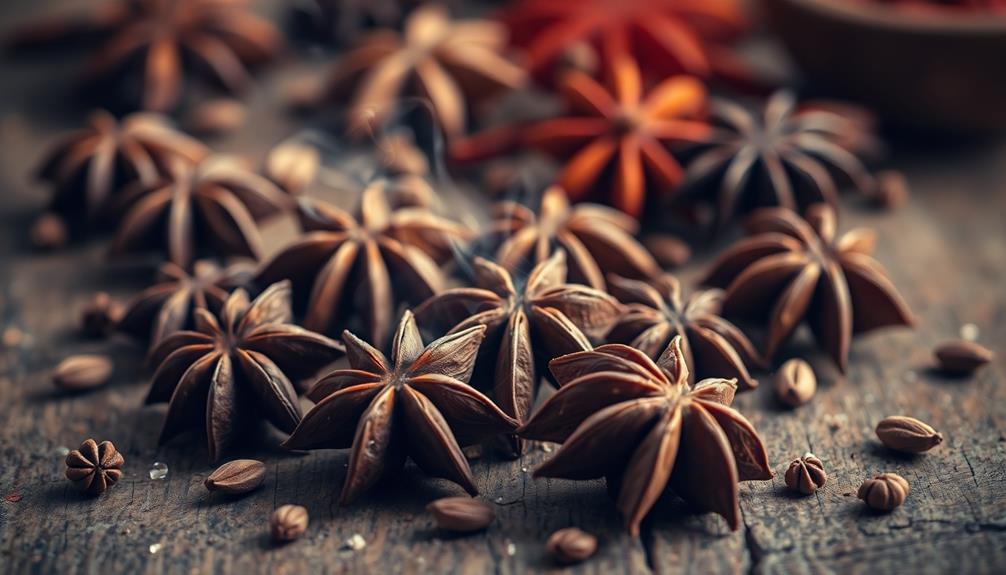
Amid the rich tapestry of scents in the culinary world, star anise stands out with its bold and captivating aroma.
You'll discover that the scent profiles of star anise are quite unique, combining intense, spicy sweetness with a sharp licorice-like note. This comes from anethole, a compound that gives it that distinctive flair.
As you explore its fragrance, you'll notice how it evolves into warming balsamic undertones, creating a comforting depth that feels just right.
Using star anise essential oil can enhance your space, especially during fall and the holiday season.
Its powerful fragrance pairs beautifully with warm spices like cardamom and cinnamon, but also with fresh notes like mandarin and peppermint.
This versatility adds layers to any scent blend you create. Incorporating star anise into your home or cooking can evoke feelings of comfort and sophistication.
Frequently Asked Questions
What Is the Smell of Star Anise?
When you encounter star anise, you'll notice its bold, spicy sweetness and sharp, licorice-like notes. As the aroma unfolds, it warms with balsamic undertones, creating a comforting depth that's truly captivating.
Does Anise Smell Good?
You'll likely find anise's sweet, spicy aroma quite appealing. Its warm scent, reminiscent of black licorice, creates a comforting atmosphere, making it a favorite in culinary delights and festive fragrances that invite enjoyment and nostalgia.
Why Does Star Anise Smell Like Licorice?
Star anise smells like licorice because it contains anethole, the same compound found in anise. This gives it that distinct, sweet aroma, blending spiciness with warming notes that you might find particularly delightful.
What Is the Aroma of Anise?
When you encounter anise, you'll notice its sweet, spicy aroma, reminiscent of black licorice. It combines warm, balsamic undertones with herbal and woody notes, creating an inviting, complex fragrance that evokes warmth and nostalgia. Due to its distinct profile, anise is often used in both culinary and medicinal applications, enhancing dishes and aiding digestion. Its familiar scent can be a comforting reminder of festive treats or soothing herbal remedies. While it stands in stark contrast to less appealing smells, such as common odors around the anus, its pleasant fragrance can easily refresh and neutralize less pleasant environments.
